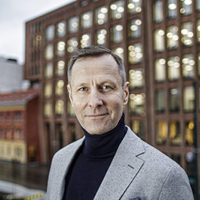

Recipe for Future Living 

Location & Year
Oslo, 2019
Area
16000 m2
In collaboration with
Asplan Viak, Deichman Bibliotek Stovner, Landskap +, Léva urban design, Mad Communication, Resirqel AS, Vill energi
Team
Nicolai Riise, Rune Arleth, Åshild Wangensteen Bjørvik, Espen Vik, Matthew Fentem, Kyrre Sundal, Kimberly Wolf, Nikolaos Farmakis, Kurt Singstad og Bengt Magnus S. Carlson
The overriding concept behind the proposal is the reuse of building materials. The team, which incorporates industry leaders such as Ineo Eiendom and Resirqel along with expert advisors from Asplan Viak and Vill Urbanisme, have created a realistic project where the reuse and recycling of building components is implemented in all phases.
Recipe for Future Living – Stovner
Mad architects have won the international Reinventing Cities competition with their proposal, Recipe for Future Living , in Stovner Oslo. The project takes the construction industry’s enormous waste problem and turns it into an invaluable and unique resource, with the project basing itself entirely on circular economy, the use of sustainable resources and reuse. The needs of the local community define the design of the concept, with the aim of elevating Stovner, improving future-prospects for the entire city district.
The project demonstrates that a full-scale urban development project can both be functional and sustainable, whilst at the same time looking fantastic!
no images were found
Recipe for Future Living is the result of the projects high climate ambitions and Stovner’s unique local identity. A strong local and cultural connection has been important in the development process and the team behind Recipe for Future Living have recruited several contributors who will help to create job opportunities and affordable housing for young people trying to establish themselves. Recipe for Future Living is a real ‘surprise package’ which reduces the carbon footprint, helps to reduce social inequality, building and strengthening a good local community.
With this project we have really raised the bar for what is possible when it comes to the reuse of materials in new projects. What is significant about this project is that we are also reusing the load bearing structure from other buildings. We may even take parts from the old government district, says Nicolai Riise, CEO of Mad arkitekter.
The team is built up of members from a wide range of disciplines, where everyone is an expert in their field. To fully understand what Stovner truly needs, the team has also collaborated with a senior librarian from the Stovner library.
The developers are Stavanger based Ineo Eiendom. They have a number of other projects where they have also prioritized social sustainability. To work in this way is the future of how to run building development. We have worked with a holistic approach to what the entire Stovner district requires, from housing to commerce, to employment opportunities and places where everyone can meet, explains project developer for Ineo Eiendom, Vetle Bringsjord. Riise also explains that the project has a large focus on the green, where the landscape is also reused, that all vegetation is edible and that the residents can wander from roof garden to roof garden.
The earth – a closed system
The overriding concept for the proposal is the reuse of building materials. The team incorporates industry leaders such as Ineo Eiendom and Resirqel. Along with the best consultants from Asplan Viak and Vill Urbanisme, the team have designed a realistic project, where the reuse and upcycling of building components is implemented in all phases.
The construction industry must open its eyes; we cannot continue to extract and dispose of raw materials in the way in which we have done for the entirety of modern history. Upcycling and reuse are the only way in which we can build, if we simultaneously wish to maintain the world as we know it. Mad, along with the team behind the project, are at the forefront of this way of thinking.
A green neighborhood
Equally important as the building, are the unbuilt areas of the site. The projects landscape architecture guarantees good conditions for vegetation, biodiversity, wildlife and stormwater management – whilst providing outdoor spaces suited for smaller and larger meeting places. Great importance is placed on the quality of the space between the buildings, which have been designed for good, safe and exciting outdoor spaces, which will help to develop and strengthen the local unity and create a local identity.
A model for change
Recipe for Future Living will also house an innovative start-up environment, which will support professional and local initiatives. The main focus will be on accelerating proposals / solutions which tackle the environmental crisis and provide a concrete answer to how we can live greener.







 Čeština
Čeština